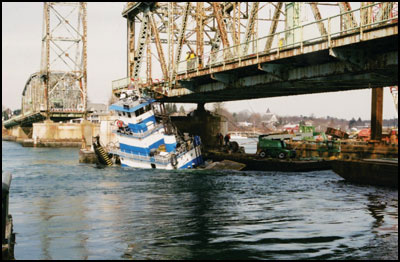
 |
 |
 |
 |
 |
 |
 |
 |
|||||||
|

Preserve Our Working Waterfront (continued)Portsmouth was settled in 1623, and has always had a working waterfront. Shipbuilding (from sailing ships to submarines) has long been her heritage, as has been fishing, and the shipping of trade goods. The working waterfront has shaped the development and character of the city, and of her people. To lose that aspect would take away something as vital to the city’s essence as its historic streets and iconic North Church. Not long ago, Portsmouth had four working tugboats. With the leaving of the Eugenia Moran, she now has two. If you wish to preserve the working waterfront, and the jobs it supports, contact your state representatives. Update on Eugenia MoranAccording to Moran Towing, and the Portsmouth River Pilots, the Eugenia Moran is still with the Moran fleet but is now based down South and busily working in warmer waters. At our Tugboat Alley book signing on November 24th, Denise and Crystal were pleased to meet many tugboat fans, and also the former engineer of the Eugenia Moran, Thurston Powell. Thurston was on the Eugenia Moran the day of the rescue. At the time the radio call came in, they were way up into the bay, past the Atlantic Terminal. They had to put on quite a burst of speed to get to the Miss Stacy in time. He was proud of the Eugenia Moran's role, but said it was "all in a day's work." He also noted that she was a good boat. Update on Portsmouth Tug FleetMoran Towing also reports that Portsmouth is happy to welcome a third tugboat to the waterfront for the winter. New in port is the Town Point; she joins the Drumpoint and Mary Coppedge to aid in guiding ships in and out of the harbor. Tugboats Free Trapped TankerOn April 1, 2013, Portsmouth tugs were urgently pressed into service as they helped free the MV Harbour Feature after it crashed into the Sarah Mildred Long Bridge and became pinned there. The 473-foot long tanker, which was carrying tallow oil, broke free from its moorings at the state pier and struck the downriver side of the bridge. The tugs guided the Harbour Feature back to the pier. The incident is being investigated and both the bridge, which also spans the Piscataqua, and the ship, suffered damage. Tugs Guide North Bridge Span into PlacePortsmouth tugboats helped guide the north span of the new Memorial Bridge into place in March. The bridge, which is scheduled to be completed in July, spans the Piscataqua River and is a key connector between Portsmouth, NH and Kittery, ME. Next to be installed will be the bridge's towers. Tugboats Aid in Moving First Span into Place Portsmouth tugboats were part of the team working to move the first section of the new Memorial Bridge into place on January 15, 2013. The 300-foot section, called the South Span, came down river on a barge called the "Cape Cod," as tugboats guided the barge along. The 650-ton section was painstakingly lowered into place on its piers while hundreds lined the shore, watching the historic effort. The bridge is expected to open in July of this year. Coming up:Tugs are expected to be on hand once again as the north span is maneuvered into place in late March or early April 2013. If you love tugboats, check out www.tugboatinformation.com to learn more.
|
Copyright © 2012 Denise F. Brown. All Rights Reserved. |
Home | About the Author and the Illustrator | Events/News | About Tugboats | Our Store | Links | Contact Us |